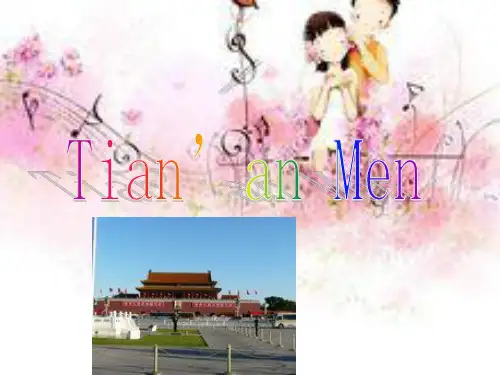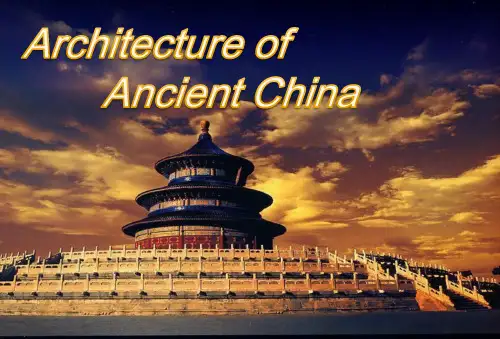中国四大名楼 PPT英文版
- 格式:ppt
- 大小:14.93 MB
- 文档页数:27











Chinese Famous Architecture: An Introduction Chinese architecture has a rich history that dates back thousands of years. From ancient temples to modern skyscrapers, China boasts a diverse range of remarkable architectural treasures. In this article, we will explore some of the most renowned Chinese architectural masterpieces.The Great Wall of ChinaThe Great Wall of China is an iconic symbol of Chinese civilization and one of the world’s most famous architectural wonders. Extending over 13,000 miles, it was built to protect the Chinese empire from invasions. Made of stone, brick, tamped earth, and other materials, the Great Wall stands as a testament to the ingenuity and determination of the Chinese people.The Forbidden CityLocated in the heart of Beijing, the Forbidden City served as the imperial palace for over 500 years. With its intricate design, grand halls, and beautiful gardens, it showcases the brilliance of traditional Chinese architecture. The Forbidden City is a UNESCO World Heritage site and a popular tourist destination, offering visitors a glimpse into China’s imperial past.The Terracotta ArmyDiscovered in 1974 near Xi’an, the Terracotta Army is an extraordinary archaeological find. The army consists of thousands of life-sized terracotta soldiers, horses, and chariots that were buried to protect Emperor Qin Shi Huang in the afterlife. Each soldier has distinct facial features, reflecting the remarkable craftsmanship of the ancient Chinese artisans.The Temple of HeavenThe Temple of Heaven is a masterpiece of Ming Dynasty architecture located in Beijing. It was a place where emperors of the Ming and Qing dynasties would come to pray for good harvests. The complex includes the Hall of Prayer for Good Harvests, the Imperial Vault of Heaven, and the Circular Mound Altar. Its harmonious design and exquisite details make it a prime example of traditional Chinese religious architecture.The Shanghai TowerAs a modern architectural marvel, the Shanghai Tower dominates the city’s skyline. With its 128 floors reaching a height of 2,073 feet, it is one of the tallest buildings in the world. The tower’s unique design features a twisting exterior thatreduces wind load and contributes to its structural stability. The Shanghai Tower is a symbol of China’s rapid urbanization and technological advancemen t.The Lingering GardenThe Lingering Garden in Suzhou is a classical Chinese garden renowned for its poetic beauty and tranquil atmosphere. It was built during the Ming Dynasty and captures the essence of Chinese garden design principles. The garden features a harmonious blend of pavilions, rock formations, water features, and meticulously arranged plants. It is a UNESCO World Heritage site and a popular destination for those seeking serenity in nature.The Yellow Crane TowerThe Yellow Crane Tower is a historic tower located in Wuhan. Originally built in the 3rd century, it has been rebuilt and renovated multiple times throughout history. The tower offers breathtaking views of the Yangtze River and the cityscape. It has served as an inspiration for countless poets and artists, becoming an enduring symbol of Chinese culture and literary excellence.ConclusionChinese architecture is a testament to the country’s rich history, cultural depth, and architectural achievements. From ancient wonders like the Great Wall of China and the Terracotta Army to modern marvels like the Shanghai Tower, these architectural treasures represent the ingenuity, artistry, and cultural significance of China. Exploring these iconic structures is a truly immersive experience that allows you to appreciate the beauty and grandeur of Chinese architecture throughout the ages.。
中国四大名楼英文介绍The Four Great Towers of ChinaChina is a country rich in cultural heritage, with a long and storied history that has left an indelible mark on the world. Among the many architectural wonders that grace the landscapes of this ancient land, four towers stand out as true icons of Chinese ingenuity and craftsmanship. These four great towers, known as the "Four Great Towers of China," have captured the imagination of travelers and scholars alike, and their stories are woven into the very fabric of Chinese civilization.The first of these remarkable structures is the Yueyang Tower, located in the city of Yueyang in Hunan province. This towering edifice, dating back to the Song Dynasty, is renowned for its strategic location overlooking the Yangtze River and the Dongting Lake. The tower's striking appearance, with its elegant pavilion-style architecture and intricate carvings, has made it a beloved landmark for both locals and visitors. The Yueyang Tower has long been celebrated in Chinese poetry and literature, with its commanding presence inspiring countless works of art and literature.The second of the Four Great Towers is the Tengwang Pavilion, situated in the city of Nanchang, Jiangxi province. This magnificent structure, built during the Tang Dynasty, is renowned for its harmonious blend of architectural styles and its stunning location on the banks of the Gan River. The Tengwang Pavilion is renowned for its elaborate decorations, including intricate carvings, delicate frescoes, and intricate tile work. The tower's commanding presence and its breathtaking views of the surrounding landscape have made it a popular destination for tourists and a source of immense pride for the people of Nanchang.The third of the Four Great Towers is the Huanghelou Tower, located in the city of Wuhan, Hubei province. This towering structure, dating back to the Ming Dynasty, is renowned for its striking appearance and its strategic location overlooking the Yangtze River. The Huanghelou Tower is known for its elegant, multi-tiered design and its intricate decorations, which include elaborate carvings, delicate frescoes, and intricate tile work. The tower's commanding presence and its breathtaking views of the surrounding landscape have made it a beloved landmark for both locals and visitors.The fourth and final of the Four Great Towers is the Daming Palace, located in the city of Xi'an, Shaanxi province. This grand complex, which was once the imperial palace of the Tang Dynasty, is renowned for its stunning architecture and its rich cultural heritage. TheDaming Palace is known for its vast, sprawling layout, which includes a number of impressive towers and pavilions, as well as intricate gardens and courtyards. The palace's stunning appearance and its rich history have made it a beloved destination for tourists and a source of immense pride for the people of Xi'an.Each of these four great towers is a testament to the enduring spirit of Chinese culture and the ingenuity of its people. From the elegant Yueyang Tower to the grand Daming Palace, these structures have captured the imagination of countless generations and have become beloved landmarks that continue to inspire awe and wonder in all who behold them. Whether you are a seasoned traveler or a curious explorer, a visit to these four great towers is an essential part of any journey through the rich and vibrant tapestry of Chinese civilization.。